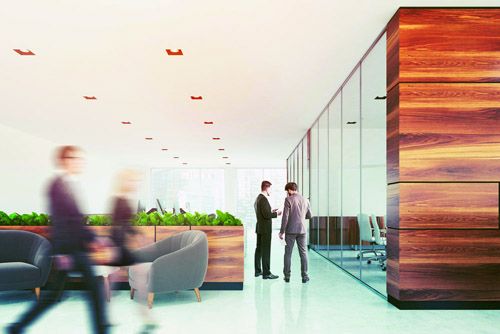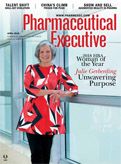Give Them Their Space
Pharmaceutical Executive
To attract the best talent, offer a workplace that inspires.
Building a team isn’t just about hiring the right people-offer a workplace that inspires to attract and keep the best talent
At the heart of every scientific breakthrough lies the people who made it happen. As the pharmaceutical industry faces increasing pressures to innovate and adapt, the challenge of finding and keeping exceptional talent looms large.

Pharma companies are in the midst of a dramatic transformation, yet the physical workplace has remained largely unchanged. Now, leaders are gaining a greater appreciation and understanding of how places and spaces can help accelerate their business and bring their best ideas to life, according to JLL’s latest Life Sciences Workplace Insights report.
Aesthetics matter
Developing an innovative and productive team isn’t just about hiring the right people-it’s about creating the right kind of environment that will bring the best talent through the door and getting that talent to stay. It’s about designing a workplace that keeps the needs of employees front and center so that they feel fully engaged in work and remain productive.
Stark, rigid labs are out. Open, flexible, and welcoming environments are in. Attracting highly sought-after scientists, researchers, and data analysts will require an inspiring workplace where people choose to show up and give their best. Real estate decisions and workplace strategies must be tightly aligned as companies examine the core questions ahead.
Where does our future talent reside?
Life sciences clusters such as Boston, San Francisco, and New York City are magnets for industry players of all sizes. And we don’t have to look too deep to understand why. Strong ecosystems in these cities support research and funding needs. But perhaps the most critical selling point for companies is the fact that these hubs are breeding grounds for the best and brightest scientific minds, thanks to the region’s influential research institutions and universities.
Finding a place to put a stake in the ground is another story. Workspace is scarce in nearly all of the top 10 US life sciences clusters, with vacancy rates under 10%. In turn, the lack of space is pushing up rents. Companies that want to be in the center of the action need to approach their real estate strategies more creatively.
Some companies are moving to the surrounding suburbs of major markets, trading a central location for more competitive pricing and/or better amenities. Waltham, Mass.-on the outskirts of Boston-has lured a number of life sciences companies away from high-priced Cambridge labs. Exosome Diagnostics and Bioverativ, a spin-out of Cambridge-based Biogen, have both recently moved into Waltham. Neighboring Lexington is home to the first-ever speculative suburban Boston lab building, which didn’t sit on the market long before Wave Life Sciences leased the entire 91,000-square-foot facility. King Street Property, which built the development, is actively building more new space for life sciences companies in both Waltham, Lexington, and surrounding areas.
Pharma companies are also collaborating with local universities and real estate developers to ignite new hubs. Spark Therapeutics recently signed on as the first tenant of a new $3.5 billion development in Philadelphia called Schuylkill Yards, which is positioning itself as a new hub for technology and life sciences companies. Just blocks away from Drexel University and the University of Pennsylvania, the center aims to bring together leading research institutions with incubators, startups, and established companies in a walkable, work-live-play community.
Some industry giants are finding success with setting up smaller outposts across a variety of hotspots. For example, Amgen is relocating 100 R&D employees from its Thousand Oaks, Calif., headquarters to sites in South San Francisco and Boston. Meanwhile, New Jersey-based Merck & Co. is establishing a West Coast headquarters in South San Francisco, joining companies such as Genentech and Johnson & Johnson.
Regardless of the approach, a presence in or near the major life sciences hubs has become non-negotiable for growing companies that face increasingly fierce competition for talent. Exacerbating the situation: tech companies have entered the fray. A prime example: Alphabet’s Calico subsidiary is going after the same computational biologists and top academic researchers that are already in short supply for the industry.
How do we create an environment that will attract (and keep) the best talent?
How can pharma companies compete with major tech players? While most pharma organizations won’t set aside a massage room on-campus or offer free food to employees all day long, there are valuable lessons to take away from the tech world. The underlying philosophy-making work an enjoyable experience for employees-is gaining momentum across all industries.
Newly constructed real estate developments are helping companies lure employees who want a workplace with the latest bells and whistles. The Alexandria at Torrey Pines, which was designed to attract life sciences and tech companies to one of San Diego’s hot neighborhoods, gives tenants access to large conference rooms, concierge services, and a restaurant with a celebrity chef.
Relocating to a shiny new office isn’t always possible, but smaller measures can have an equally powerful impact on employees. Solutions can be as simple as creating a space where employees can recharge or unwind when they need a change of scenery-whether it’s a meditation room or an informal lounge with a fancy coffee station. Giving employees more choices also goes a long way toward influencing work happiness. Employees feel empowered when they can choose from a variety of work spaces or adjust their workspace to fit their unique needs.
How the organization’s culture is reflected and supported in the workplace increasingly matters. Even investors are asking questions. PwC’s latest CEO survey found that more than 700 publicly traded companies talked about culture with their investors. Open and honest cultures are a distinguishing feature that draws in good people. Workplace design-such as open collaboration areas with glass doors-can help communicate a sense of transparency and honesty.
How can we create workspaces that boost productivity and efficiency?
Every company has unique needs and can uncover the right solutions by polling employees about their physical workspace. What irritates employees-is it a lack of collaboration areas, limited private spaces, or the office temperature? What features would they change in the office? Understanding frustrations and adjusting the space to reduce or eliminate them can help employees feel more engaged and, ultimately, more productive.
Thoughtfully designed workplaces today offer a diverse mix of spaces that cater to the changing needs of employees, from collaboration zones to small conference rooms to research areas. Genentech and AstraZeneca are reducing assigned seating, moving instead to reserve-able private spaces and open seating. In fact, companies across many industries are adopting more fluid seating strategies to accommodate a workforce that increasingly comprises remote and on-demand workers.
The overall layout of space also needs to be more flexible to accommodate rapidly shifting research needs. Lab space has long monopolized the bulk of life sciences buildings, but as more R&D work shifts to data analysis, companies may need to dedicate more square footage to office space.
The one constant is change. Workplace design must support a culture of constant disruption. Architects and designers can build flexibility into everything from the functionality of rooms down to the furniture, including moveable benches, retractable cords that hang from the ceiling, and plug-and-play research equipment. Shortened research timelines and the pressure to advance products to market quickly means that labs have to be lighter and faster. The ability to use lab space for different projects at the same time or to quickly transition to a new project can help reduce total real estate costs.
Connecting the dots
Constant change makes it difficult to pinpoint which way the wind is shifting. Developing more flexible real estate strategies that are aligned with future workforce strategies can help organizations adjust course more easily. Keeping employee needs in the center of all critical decisions will point you in the right direction and give you the advantage in the war for talent.
Roger Humphrey is Executive Managing Director of the Life Sciences practice at JLL
